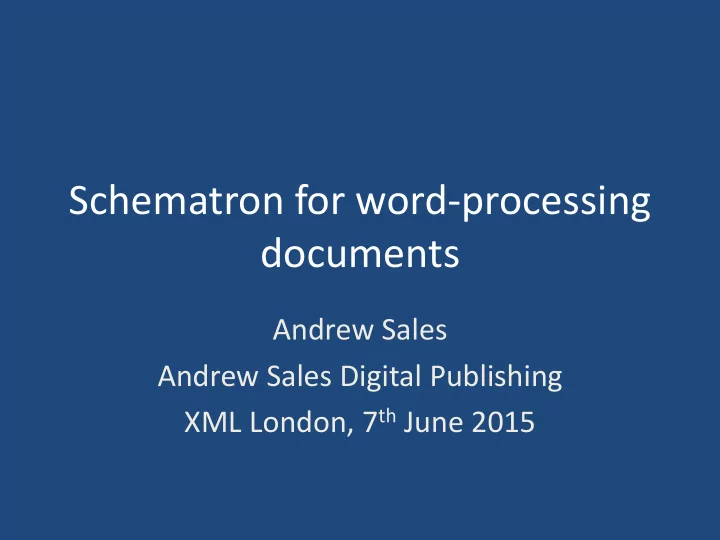

Schematron for word-processing documents Andrew Sales Andrew Sales Digital Publishing XML London, 7 th June 2015
Background • Why use Word to capture XML? – cost – skills, familiarity – legacy workflows & content – dual approach: markup and typesetting • Cons – working in unstructured environment – underlying markup hidden
Quality • If you do use Word, you need (ideally): – consistently-applied styles – well-designed template • All styled Normal produces sub-optimal results
Approaches • Before OOXML/ODF: macros • After: Schematron is possible – it’s all XML behind the scenes – benefit of XML output from validation (SVRL) – write XPaths (XSLT, XQuery…) rather than bespoke code – abstraction possible – standards-based (including source markup!)
Types of rule: unexpected styles "All paragraph styles in the body of the document must be a member of a controlled list of styles." <pattern id="unexpected-para-style"> <let name="allowed-para-styles" value="('articlehead', 'bodytext', 'bibhead', 'bib')"/> <rule context="w:p[not(parent::w:ftr) and not(parent::w:footnote) and not(parent::w:endnote)][w:r]" > <report test="not(w:pPr/w:pStyle/@w:val = $allowed-para-styles)" >unexpected para style '<value-of select="w:pPr/w:pStyle/@w:val"/>'; expected one of: <value-of select="$allowed-para-styles"/> </report> </rule> </pattern>
Unexpected sequence of styles “The first bibliographic citation must be immediately preceded by a bibliography heading .” <pattern id="missing-bib-heading"> <rule context="w:p[w:pPr/w:pStyle/@w:val='bib'] [not(preceding::w:p[w:pPr/w:pStyle/@w:val = 'bib'])]" > <assert test="preceding::w:p[w:pPr/w:pStyle/@w:val = 'bibhead']" > no bibliography heading found </assert> </rule> </pattern>
Format of datatypes, e.g. dates "A date in a bibliographic citation must conform to the format YYYY-MM-DD .“ <pattern id="bad-date"> <rule context="w:r[w:rPr/w:rStyle/@w:val ='bibdate']" > <assert test=". castable as xs:date" > text styled as 'bibdate' must be in the format 'YYYY-MM-DD'; got '<value-of select="."/>'</assert> </rule> </pattern>
Co-occurrence constraints "Every citation reference must have a corresponding citation number in the bibliography .“ <pattern id="broken-citation-link"> <let name="citation-refs" value="//w:r[w:rPr/w:rStyle/@w:val ='bibref']"/> <rule context="w:r[w:rPr/w:rStyle/@w:val = 'bibnum']" > <assert test=". = $citation-refs" > could not find a citation reference to this citation: '<value-of select="."/>'</assert> </rule> </pattern>
Visualisation
Visualisation (2) • Demo(s)… • Errors limited to a renderable location
Simplification • Flat structure & verbose markup mean tedious rule-writing • Options: – simplify the rules – simplify the source – domain-specific language?
Simplified rules <pattern id="expected-preceding-style" abstract="true"> <rule context="w:p[w:pPr/w:pStyle/@w:val = $context-style] [not(preceding::w:p[w:pPr/w:pStyle/@w:val = $context-style])]"> <assert test="preceding::w:p [w:pPr/w:pStyle/@w:val = $expected-preceding-style]"> first occurrence of style '<value-of select="$context-style"/>' has no preceding style '<value-of select="$expected-preceding- style"/>' </assert> </rule> </pattern> <pattern id="missing-bib-heading" is-a="expected-preceding-style"> <param name="context-style" value="'bib'"/> <param name="expected-preceding-style" value="'bibhead'"/> </pattern>
Simplified source <doc> <sect> <p style="articlehead"> The application of Schematron schemas to word- processing documents</p> <p style="bodytext">As traditional print-based publishing has made the transition into the digital age, a convention has developed in some quarters of capturing or even typesetting content using word- processing applications.</p> <!-- lots more here... --> <p style="heading 2">References</p> <p style="bib"> <span style="bibnum"> [1]</span> <url address="http://www.ecma- international.org/publications/standards/Ecma-376.htm" >http://www.ecma-international.org/publications/standards/Ecma- 376.htm</url>. Retrieved <span style="bibdate">2015-03-08</span>.</p> <! – - etc. --> </sect> </doc>
DSL • More declarative, schema-like • Can drive auto-generation of Schematron schema
Style schema <Document> <Ref name="articlehead"/> <OneOrMore> <Ref name="bodytext"/> </OneOrMore> <Optional> <Group> <Ref name="bibhead"/> <OneOrMore> <Ref name="bib"/> </OneOrMore> </Group> </Optional> </Document>
Other office documents • E.g. spreadsheets • Demo…
Conclusion • Quality control through Schematron possible although XML may be “hidden” • Errors can be presented in context to user in familiar environment • Simplify: rules/source; DSL? • Applicable to other office document types
Recommend
More recommend